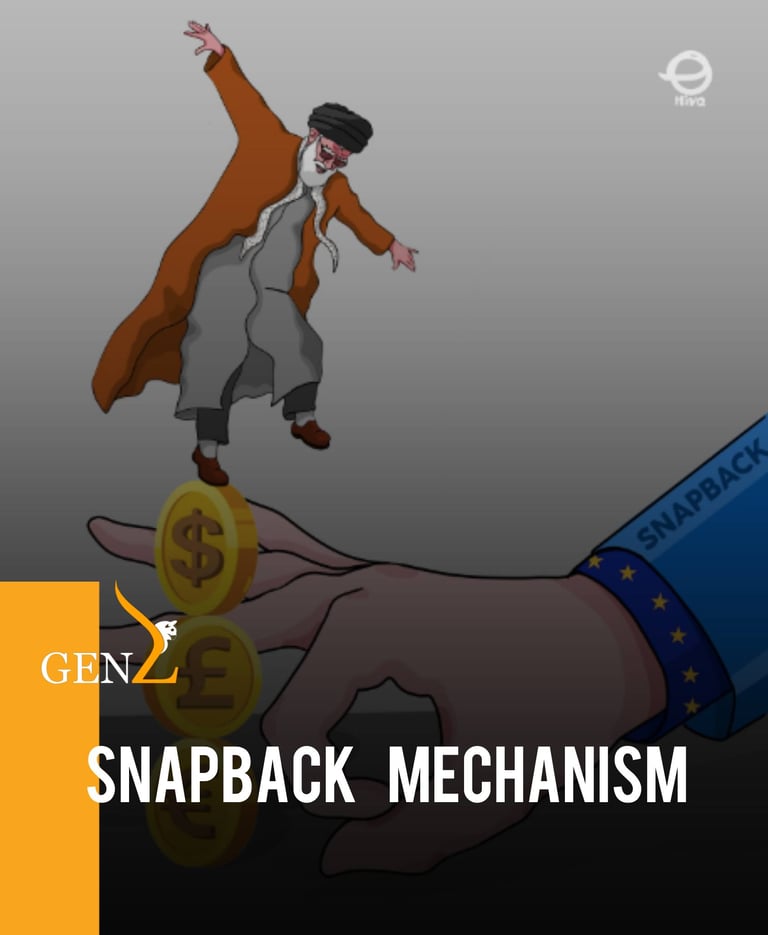The Snapback Mechanism and the Positive Reaction of Iran’s Middle Class
Introduction In the realm of international politics, the “snapback mechanism” is one of the most important and controversial tools in the Iran nuclear deal (JCPOA) and UN Security Council Resolution 2231. This mechanism allows signatory states to trigger a process that automatically reinstates UN sanctions if they allege a “material breach” of Iran’s commitments. In autumn 2025, news that the snapback had been triggered captured public attention in Iran once again. One might have expected widespread pessimism and despair, but among a significant segment of society — especially the urban middle class — the reaction was surprisingly positive, hopeful, or at least justificatory. Tired Iranians chose the worst of bad options in the hope that intense external pressure might become a savior for this wounded land. This article examines the reasons behind that phenomenon.
10/6/20252 min read


The Snapback Mechanism and the Positive Reaction of Iran’s Middle Class
Introduction
In the realm of international politics, the “snapback mechanism” is one of the most important and controversial tools in the Iran nuclear deal (JCPOA) and UN Security Council Resolution 2231. This mechanism allows signatory states to trigger a process that automatically reinstates UN sanctions if they allege a “material breach” of Iran’s commitments.
In autumn 2025, news that the snapback had been triggered captured public attention in Iran once again. One might have expected widespread pessimism and despair, but among a significant segment of society, especially the urban middle class, the reaction was surprisingly positive, hopeful, or at least justificatory. Tired Iranians chose the worst of bad options in the hope that intense external pressure might become a savior for this wounded land.
This article examines the reasons behind that phenomenon.
Body
1. The Snapback Mechanism and Its Consequences
The snapback is a process that reinstates suspended sanctions without a new Security Council vote. Its main consequences include:
● Economic: The return of trade and financial restrictions, severe pressure on currency and inflation, and a drop in purchasing power.
After the snapback, we clearly observed skyrocketing exchange rates and gold prices, seriously threatening people’s livelihoods, and gasoline price hikes may soon follow.
● Legal and International: Further isolation of the Islamic Republic and the potential for reduced cooperation with the IAEA or even threats of withdrawal from the NPT.
For the first time in 46 years, the Islamic Republic finds itself fully isolated even by parts of Europe.
● Political and Psychological: The creation of a sense of external pressure and an intensification of either a “resistance” narrative or demands for fundamental change.
External and internal pressure could ultimately bring down this worn-out, dysfunctional system.
2. Why Did the Middle Class , which makes up the bulk of society, React Positively?
Hope for radical change and escape from 46 years of limbo.
For many, the choice was between “bad” and “worse.” When avoiding sanctions seemed impossible, accepting them while hoping external pressure would trigger fundamental change appeared to be a more rational response.
A portion of the middle class viewed this pressure as an opportunity for domestic political and social transformation. The era of the JCPOA, endless reforms, and interminable negotiations is over in the eyes of many Iranians. There is now a gulf of blood between the Iranian people and these corrupt killers. Overall, increased external pressure can intensify internal dissatisfaction and pave the way for deeper change.
Iranians, disillusioned and enraged at the system, will grasp any rope that might topple it, even if they know they will suffer the most in the short term. At least they believe this is their only route to salvation.
Conclusion
The activation of the snapback in 2025 had not only economic and legal ramifications but also significant symbolic and psychological impacts on Iranian society. Contrary to expectations, the middle class did not react purely with despair; instead, reactions combined hope, belief in possible fundamental change, and efforts to justify the temporary pain as necessary for long-term improvement.
This suggests that Iran’s society, especially the middle class, which forms the majority, after years of external pressure, domestic hardship, and political paralysis, has chosen a form of temporary “social resilience” in pursuit of its ultimate goal: the removal of this destructive and corrupt regime.
